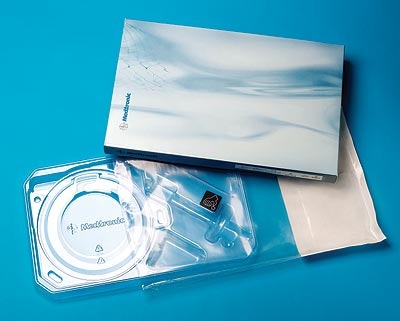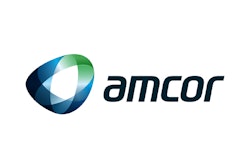After the company developed a new surgical stent, Medtronic Vascular went to the drawing boards to develop a new smaller two-piece thermoformed container that protects the product better. The Santa Rosa, CA-based medical device developer worked closely with Prent Corp. on the tray design. The tray recently won the Critical Barrier Award from the Society of Plastics Engineers.
The “heart” of the new package is the two-piece thermoform that’s loaded, closed, and inserted into an outer pouch and carton prior to sterilizing. The product is called the Aurora Self-Expanding Biliary Stent, an improved version of Medtronic’s earlier self-expanding stent systems. Stents are used to alleviate arterial blockage.
“We looked at the existing product packaging for our earlier stent systems, and took into consideration the years of experience we had with that packaging,” says Andrew Fronk, principal packaging engineer at Medtronic Vascular. “We wanted to make the packaging smaller overall, and we wanted to protect the stent better, while essentially protecting the pouch from the tray by removing sharp edges or abrasion points. We believe we succeeded on all accounts.”
Fronk says that a cross-functional team from Medtronic Vascular worked with Prent and with customers to design the new tray. “Prent took our laundry list of desired improvements and developed initial designs,” he says. “We asked for changes, and this process continued for several months. Even after we finally tested some sample thermoforms, we made changes to improve how the handle of the device could be removed from the tray and how the catheter was restrained.”
3-D modeling
Prent used three-dimensional solid modeling technology in its designs and for making the molds. Both were machined using CNC technology. Each tray was pressure-formed using computerized controls, and the molds employed plug assist.
Cavities in the thermoform keep the product handle in place during loading and shipping. A formed finger slot makes it easy for the handle and catheter to be safely removed.
A return flange on the tray makes loading it easier while eliminating any chance of abrasion to the outer pouch. Snap bars were engineered around the catheter coil cavity to hold the tray and lid securely. The formed lid is trimmed in-line and features a die-cut opening in the center to help load the catheter into the cavity.
Prent selected a 30-mil blue-tinted Glidex glycol-modified polyester sheet from GOEX Corp. This material, according to Prent, provides clarity and denestability, without the use of a silicone antiblocking agent. Medtronic wanted to use PETG because of its availability and its ease of recycling, Fronk says. Plus, Prent had a lot of experience with PETG.
“The most critical dimensions and tolerances involve the fixturing of the handle part of the device,” Fronk says. “The handle had to be secure for transport and handling to survive our rigorous ship-testing. But it also had to be loose enough for easy removal by the physician.”
Two different products are packed in the tray design, and each set of components requires its own method of sterilization, either electron beam or ethylene oxide. The ability to handle either form of sterilization was another factor that favored PETG, Fronk says.
Once the tray is loaded and closed, it’s packed into a puncture-resistant header bag from Amcor Flexibles (formerly Rexam Healthcare). The pouch uses the Tuf2000 nylon-based material for the clear web and Tyvek 1073B from DuPont for the header web. This pouch is heat-sealed and loaded into a printed paperboard carton and shipper before being sterilized.
“Because the new package is smaller than our previous designs, we’ve actually been able to save money on this design,” Fronk says. “Plus, we can fit about 20-percent more product into the batch load of the sterilizer, so we save more than just component costs.
“But the best news is that the new package has been well received by medical professionals,” Fronk concludes. “Technicians in labs like the smaller package because they can fit more product into limited shelf space. We’re encouraged that the new package and labeling has been received as well as the new stent itself.” Plus the package has received accolades from professional plastics engineers.
























